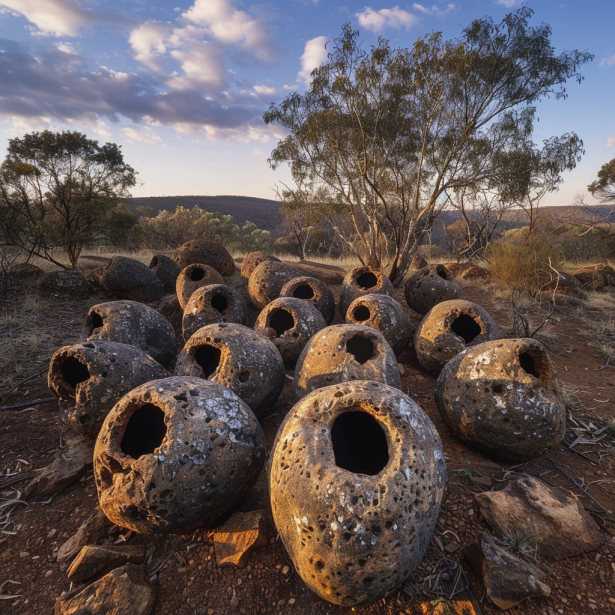Introduction
In the remote regions of Australia, ancient Aboriginal stone arrangements are challenging our understanding of early astronomy. One of the most significant sites is Wurdi Youang, located in Victoria. This arrangement of over 90 basalt stones, carefully positioned in an egg-shaped pattern, is believed to be more than 11,000 years old, potentially predating Stonehenge and the Pyramids of Giza. Researchers suggest that these stones align with the equinoxes and solstices, indicating an advanced understanding of celestial events by the ancient Aboriginal people. These findings not only highlight the astronomical knowledge of Indigenous Australians but also call for a reevaluation of the global history of astronomy.
The Discovery of Wurdi Youang
Wurdi Youang, also known as the Wurdi Youang stone arrangement, was first documented by European settlers in the 19th century. However, it wasn’t until recent decades that the site’s astronomical significance began to be understood. Located in Victoria, this stone arrangement consists of more than 90 basalt stones meticulously placed in an egg-shaped pattern, with some stones weighing up to several tons.
Astronomical Significance of Wurdi Youang
Researchers have discovered that the Wurdi Youang stones align with key celestial events. The arrangement marks the positions of the setting sun at the equinoxes and solstices. When viewed from specific points within the arrangement, the stones align with the sun’s setting position during these important astronomical events, suggesting a sophisticated understanding of the solar calendar by the ancient Aboriginal people.
Potential Age and Historical Context
The estimated age of Wurdi Youang is over 11,000 years, making it potentially older than Stonehenge and the Pyramids of Giza. This ancient construction indicates that Aboriginal Australians possessed advanced astronomical knowledge long before similar developments in other parts of the world. This challenges the conventional timeline and geographical origins of early astronomical practices.
Cultural and Spiritual Significance
For the Aboriginal people, stone arrangements like Wurdi Youang are not just astronomical tools but also hold deep cultural and spiritual significance. These sites are often linked to Dreamtime stories, which are integral to Aboriginal cosmology and worldview. The alignment of the stones with celestial events may reflect a connection between the physical landscape and the spiritual realm.
Other Notable Aboriginal Stone Arrangements
Wurdi Youang is not the only significant stone arrangement in Australia. Other sites include:
- Burrup Peninsula: Known for its extensive petroglyphs and stone arrangements.
- Narana Aboriginal Cultural Centre: Features stone arrangements used for teaching and ceremonial purposes.
- Mount Yengo: Contains stone circles and alignments associated with Aboriginal ceremonial practices.
Research and Archaeological Methods
Modern archaeological methods, including satellite imaging and ground-penetrating radar, have been employed to study these stone arrangements. These technologies help researchers understand the construction techniques and alignments without disturbing the sacred sites. Detailed surveys and measurements have confirmed the precise alignments with astronomical events.
Implications for the History of Astronomy
The findings at Wurdi Youang and other Aboriginal stone arrangements have significant implications for the global history of astronomy. They suggest that Indigenous Australians developed complex astronomical systems independently, challenging the Eurocentric narrative that places the origins of astronomy in the Middle East or Europe. This calls for a reevaluation of the contributions of ancient cultures to the field of astronomy.
Preservation and Respect for Cultural Heritage
Preserving these ancient stone arrangements is crucial for maintaining the cultural heritage of Aboriginal Australians. Efforts are being made to protect these sites from erosion, vandalism, and modern development. Collaboration with Aboriginal communities is essential to ensure that the preservation efforts respect their cultural and spiritual significance.
Conclusion
The mysterious stones of Australia, exemplified by the Wurdi Youang stone arrangement, offer a fascinating glimpse into the astronomical knowledge of ancient Aboriginal people. These ancient structures not only highlight a sophisticated understanding of celestial events but also challenge the conventional history of early astronomy. As research continues, these sites will undoubtedly provide further insights into the rich cultural heritage and scientific achievements of Indigenous Australians.
FAQs
What is Wurdi Youang?
Wurdi Youang is an ancient stone arrangement in Victoria, Australia, consisting of over 90 basalt stones carefully positioned in an egg-shaped pattern, believed to be more than 11,000 years old.
What is the astronomical significance of Wurdi Youang?
The stones at Wurdi Youang align with the setting sun at the equinoxes and solstices, indicating an advanced understanding of celestial events by the ancient Aboriginal people.
How old is the Wurdi Youang stone arrangement?
The Wurdi Youang stone arrangement is estimated to be over 11,000 years old, potentially predating Stonehenge and the Pyramids of Giza.
What other Aboriginal stone arrangements are significant?
Other significant Aboriginal stone arrangements include those at Burrup Peninsula, Narana Aboriginal Cultural Centre, and Mount Yengo.
What are the implications of these findings for the history of astronomy?
These findings suggest that Indigenous Australians developed complex astronomical systems independently, challenging the conventional narrative that places the origins of astronomy in the Middle East or Europe.
Why is it important to preserve these ancient stone arrangements?
Preserving these sites is crucial for maintaining the cultural heritage of Aboriginal Australians and ensuring that their historical and spiritual significance is respected and protected.

